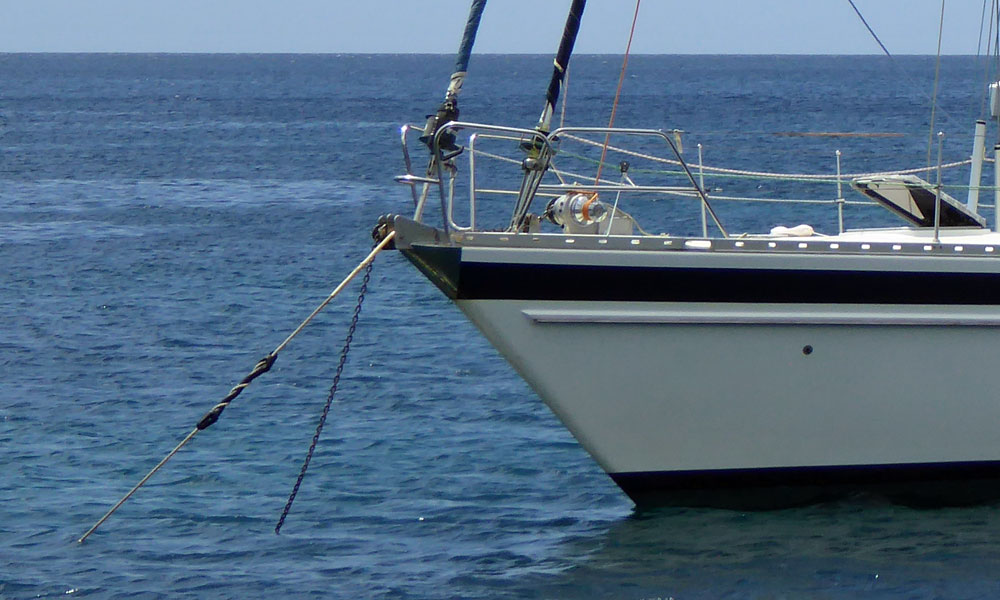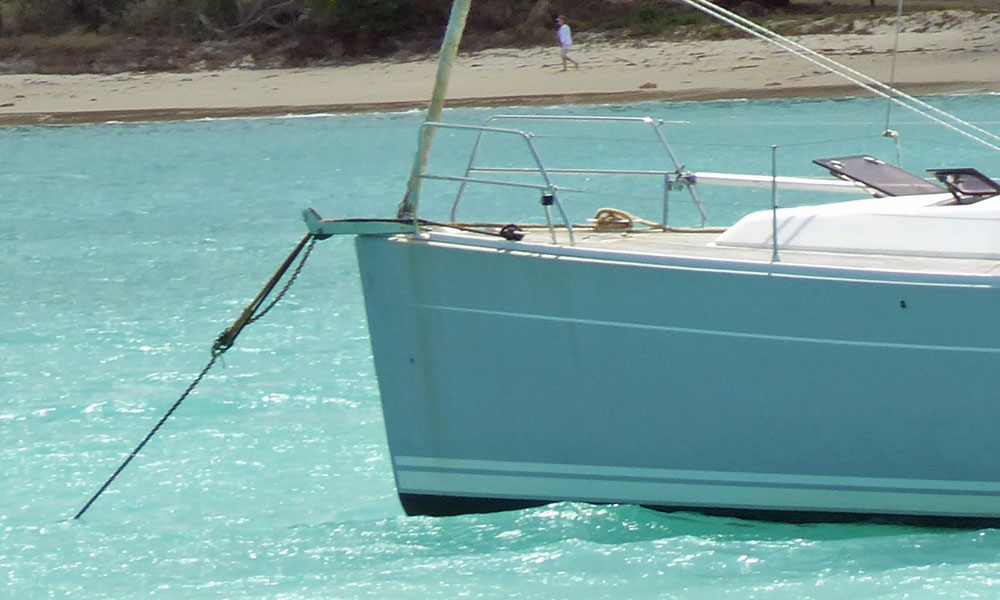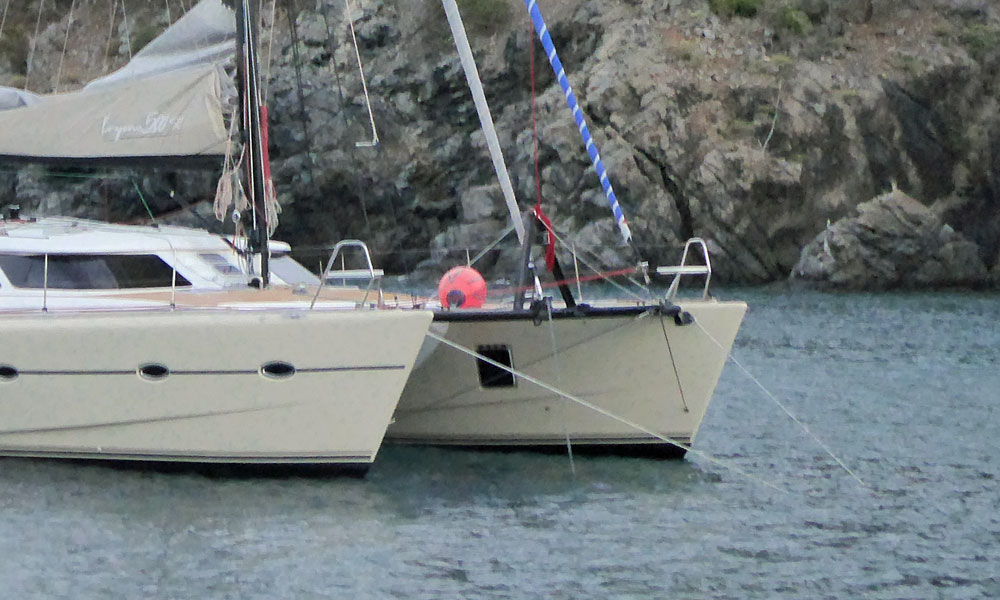Anchor Snubbers: Why Your Boat Needs One & How to Use It
In a Nutshell...
If you're using an all-chain rode, an anchor snubber isn't just a nice-to-have; it's a real must. Think of it as a crucial shock absorber between your boat and your anchor. Without one, especially when the wind gets up and things get a bit bouncy, your anchor is going to feel every jarring yank, and it might just get ripped right out of the seabed. A good anchor snubber, on the other hand, gives you a quieter, more comfortable time at anchor by smoothing out all those shock loads and taking the strain off your gear.
 An anchor snubber doing as intended
An anchor snubber doing as intendedTable of Contents
- What's the Big Deal with an Anchor Snubber?
- How Long Should Your Snubber Be?
- What's the Right Diameter for an Anchor Snubber?
- Single Snubber Line or a Bridle?
- How to Attach a Snubber to the Chain
- Choosing Your Snubber: Materials & Options
- Protecting Your Snubber from Chafe
- Looking After Your Snubber: Maintenance & Storage
- Step-by-Step: How to Deploy a Snubber
- Common Anchor Snubber Mistakes to Avoid
- Summing Up
- Frequently Asked Questions
What's the Big Deal with an Anchor Snubber?
Let's cut to the chase: if you've got an all-chain rode, you've got to have a snubber. It's the most straightforward way to stop your boat from putting violent snatch loads on your anchor. In a stiff breeze or a choppy anchorage, the boat's motion can cause the chain to jerk and snap taut. These sudden, sharp loads are far more likely to dislodge an anchor than a steady pull.
A snubber, which is really just a stretchy line, soaks up all that shock load. It turns a sharp, jarring tug into a nice, gentle, progressive strain. The bonus is that it also takes the load off your windlass, which, let's face it, isn't designed to take the full force of a boat at anchor. The key, believe it or not, is stretch. That's why those tiny little snubbers you sometimes see, which barely reach the water, are pretty much useless. All they'll do is stop the chain from making a racket in the bow fitting.
How Long Should Your Snubber Be?
Take it from me, a longer snubber is always better. As an experienced ocean sailor, I've seen it time and again: a short snubber just doesn't have enough length to stretch and do its job properly. In a real blow, especially when you're anchored in shallow water and the chain's catenary effect doesn't give you much cushion, a length of 15 metres or so isn't over the top. You can always shorten it for more moderate conditions, but you can't add to it when you need it most.
Don't forget that it's the total length of the snubber that gives you the stretch. So there's no harm at all in leading it back to a midships cleat rather than a bow cleat to give you a bit more distance.
Ultimately, the perfect length is something you get a feel for. It's a balance. You don't want your boat to spring forward in the lulls between gusts so much that she's lying broadside to the wind. You'll probably need to adjust it a bit to find the sweet spot for the conditions you're in.
 This one's far too short to be of any use whatsoever
This one's far too short to be of any use whatsoeverWhat's the Right Diameter for an Anchor Snubber?
This one's pretty simple. Go for the smallest diameter you think you can get away with. Pound for pound, a thinner line is going to stretch more than a thicker one, and remember, stretch is what it's all about here. Just don't get one so thin that it's likely to part company when the weather turns nasty!
As a rule of thumb...
| Boat Length | Recommended Snubber Line Diameter |
|---|---|
| <12m | 16mm |
| 12-16m | 20mm |
| 16-20m | 25mm |
Single Snubber Line or a Bridle?
For most monohulls, a single snubber line is the way to go. Here's the thing: if you have two lines sharing the load, you're only getting half the stretch from each one compared to a single line taking all the load. And we've already established that stretch is a good thing.
But, as with everything on a boat, there are exceptions to that rule. For instance, if you've got a catamaran, you'll need to use a bridle. Their wide stance and large windage area mean they'll swing about all over the place if you don't. And if your boat has a bobstay or a bowsprit, a bridle is essential to stop the chain from rubbing and chafing on it.
 This catamaran skipper has correctly deployed his snubber on a bridle
This catamaran skipper has correctly deployed his snubber on a bridleHow to Attach a Snubber to the Chain
When it comes to attaching your snubber to the chain, you've got two main options.
- Chain Hook: This is what most people use, and it's easy enough. You just hook it on and get on with it. The only downside is that if the load eases off for a moment, the hook can sometimes fall off.
- Rolling Hitch: I've moved to this method myself. Once you get the hang of it, it's a real game-changer. It's kinder to the chain and, best of all, a correctly tied rolling hitch simply will not fall off.
Choosing Your Snubber: Materials and Options
Picking a snubber isn't just about length and diameter. The material it's made from is a big deal, too. When it's all said and done, you want a line that's strong but also has a lot of give.
- Nylon versus Polyester: Nylon is the top dog here. Its elasticity is second to none, and it's great at soaking up shocks and snapping back into shape. Polyester is strong, sure, but it has much less stretch, which makes it a poor choice for a snubber.
- Commercially Available Products: If you're not into the DIY approach, there are lots of great options out there. Some come with a built-in chain hook, while others have bungee sections or special inserts to give you extra shock absorption. These options can be a convenient alternative if you want a ready-made solution.
Protecting Your Snubber from Chafe
A snubber is a bit of a lifesaver, but it's no good to anyone if it parts company with your boat. You've got to protect it from chafe. The most likely places for this to happen are at the bow roller, the fairleads, and any other part of the boat it might be rubbing on.
For my money, the best chafe protection is a dedicated sleeve made from split leather or tough synthetic material. Failing that, a simple but brilliant trick is to cut a slit in a piece of old hose pipe and zip-tie it around the line wherever it's touching the boat. It's a cheap and easy way to save yourself a whole world of hurt.
Looking After Your Snubber: Maintenance and Storage
Your snubber works hard, so you've got to look after it.
- Regular Inspection: Get into the habit of checking the line for wear and tear. You're looking for broken strands, any fuzziness, or fading from the sun.
- When to Replace: If your snubber starts to look a bit tired, if it feels stiff, or if it just doesn't seem to stretch like it used to, it's time to get a new one. Nylon ropes do lose their elasticity over time, so even if it looks okay, you should be replacing it every few years.
- Proper Storage: When you're not using your snubber, make sure you store it in a dry, dark place away from the sun's rays and any chemicals. A cockpit locker or a bag in your sail locker works a treat.
Step-by-Step: How to Deploy a Snubber
Snubber Deployment (Standard Conditions):
- Anchor Setting: Make sure your anchor's well and truly dug in and you've got enough chain out for the depth and conditions.
- Snubber Prep: Get your snubber line and chain hook (or get ready to tie a rolling hitch) to hand. If you're using a bridle, have that ready, too.
- Attachment: Hook the snubber on to the anchor chain, in front of the windlass. Or, get your rolling hitch tied on good and tight. If it's a bridle, attach each leg to the chain at equal distances from the bow.
- Deployment: Keep a bit of tension on the snubber and pay out more chain. You want the snubber to be long enough to give you plenty of stretch.
- Secure: Tie the snubber line(s) off to a strong point on the boat, like a bow cleat.
- Chain Slack: Pay out a bit more chain until you see a nice, big sag in the line between the snubber and the bow roller. This is your visual cue that the snubber's got the load. Aim for a sag that's roughly 10% of your snubber's deployed length.
- Windlass and Stopper: If you've got a chain stopper, engage it. Then, 'bump' your windlass a bit to transfer the load completely from the windlass to the snubber.
- Chafe Protection: Check for any potential chafe points and add protection where you need it.
Tips for Different Conditions:
- Moderate Winds and Seas: A shorter snubber should do the trick. Just make sure you've still got enough slack in the chain.
- Strong Winds and Seas: Go for the longer snubber to maximise stretch. You might want a heavier-duty line or a bridle. Pay special attention to chafe protection.
- Gusty Conditions: Keep an eye on the snubber and be ready to adjust the length. A bridle can really help keep the boat stable.
- Shallow Water: The snubber's length is super critical here because you've got less of the chain's weight helping out. Make sure you get that nice, big sag.
- Currents: A bridle can be a real saviour when the wind and current are coming from different directions. You can adjust the length of each leg to keep the bow pointed into the combined force.
Common Anchor Snubber Mistakes to Avoid
After years of anchoring in all kinds of places, I’ve seen a few common blunders that can really cause headaches.
- Using a Snubber that's Too Short: It's just a waste of time. It's got no stretch, so it can't absorb shock loads.
- Not Putting Enough Slack in the Chain: This is a big one. If the chain is still tight, the snubber isn't taking the load, and you're no better off than you were without one.
- Ignoring Chafe: Never, ever take your eye off this one. If the line is rubbing, it's dying. A few minutes spent adding chafe protection could save your whole anchoring setup.
- Overloading the Windlass: Remember, your windlass is for raising and lowering the anchor. It's not a cleat. The load of your boat at anchor should always be on a strong point, transferred there by the snubber.
Summing Up
At the end of the day, for any sailor with an all-chain rode, an anchor snubber is a fundamental piece of gear. It's that unsung hero that absorbs all the shocks and stresses on a blustery night, stopping your anchor from coming free and your boat from getting a good jarring. It ensures a comfortable, peaceful night’s rest, and what's more valuable than that when you're at anchor?
For a complete overview of all the elements of a successful anchoring strategy, be sure to read our comprehensive guide, The Definitive Guide to Anchoring a Boat.
This article was written by Dick McClary, RYA Yachtmaster and author of the RYA publications 'Offshore Sailing' and 'Fishing Afloat', member of The Yachting Journalists Association (YJA), and erstwhile member of the Ocean Cruising Club (OCC).
Frequently Asked Questions
What is the purpose of an anchor snubber?
What is the purpose of an anchor snubber?
An anchor snubber is a line used to absorb the shock and snatching loads on an anchor chain, protecting your anchor, windlass, and boat in lively conditions.
When should I use an anchor snubber on my boat?
When should I use an anchor snubber on my boat?
You should always use an anchor snubber when anchoring with an all-chain rode. You won't need one with a rope-to-chain rode because the rope already provides the required elasticity.
How do I choose the right length for an anchor snubber?
How do I choose the right length for an anchor snubber?
You want a snubber that’s long enough to provide a good bit of stretch, especially when the wind is up. It’s always best to have a longer line on board, say at least 15 metres, that you can shorten as needed.
What is the best material for an anchor snubber?
What is the best material for an anchor snubber?
Nylon is the top choice for a snubber because of its excellent stretch and strength. It's far better at absorbing shock loads than polyester.
Should I use a single snubber or a bridle?
Should I use a single snubber or a bridle?
A single snubber line is best for most monohulls, but a bridle is essential for catamarans and for monohulls to prevent chafe on a bobstay or bowsprit.
How often should I inspect my anchor snubber?
How often should I inspect my anchor snubber?
You should inspect your snubber before and after each use, paying close attention to any signs of chafe, wear, or sun damage.
What are the key signs that my snubber needs to be replaced?
What are the key signs that my snubber needs to be replaced?
If the snubber line feels stiff, has noticeable chafe marks, or is covered in fuzzy, broken fibres, it’s time to replace it. Nylon also loses its elasticity over time, so even if it looks okay, it may need replacing every few years.
Recent Articles
-
Marine Water Heating Systems: Free Hot Water from Your Boat's Engine
Dec 03, 25 05:06 PM
Tap into your engine's heat to get free hot water on board. An experienced ocean sailor's guide to marine water heating systems, calorifiers & safety. -
Marine Watermakers: An Offshore Sailor’s Guide & Practical Tips
Dec 03, 25 04:31 AM
Boost your yacht's range with Marine Watermakers. A Yachtmaster's guide to choosing, installing, and maintaining reverse osmosis desalinators for reliable, fresh water on long passages. -
Optimising Your 12-Volt Boat Fridge for Offshore Sailing & Efficiency
Dec 01, 25 11:05 AM
Master your 12-Volt Boat Fridge system. A guide for experienced sailors covering mechanics, installation, troubleshooting, and advanced electrical efficiency on extended voyages.












